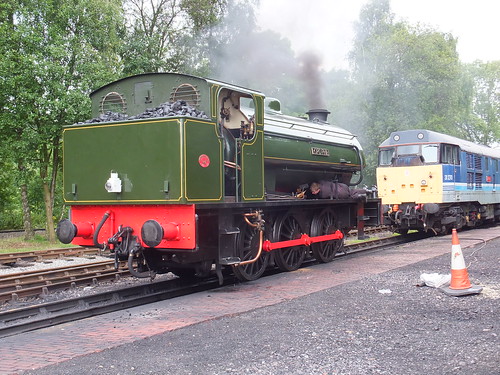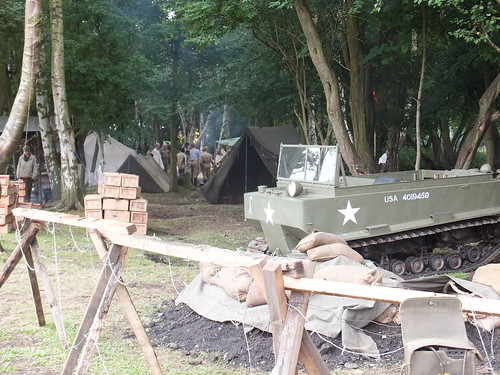In 2013, the event was held on Saturday 3rd August and Sunday 4th August. There was plenty of sunshine on both days. I was rostered as steam driver on the Sunday, using our current serviceable steam locomotive, 'Lord Phil'. Adam was fireman. We were to operate a 7-coach train top-and-tail with D8 'Penyghent'. When I arrived at Rowsley, I discovered that the locomotive had been turned, so that the chimney was at the north end. I concluded that, in a reversal of normal practice, we were going on the north end of the stock and 'Penyghent' would be at the south end. This would make a refreshing change (provided you can remember the 'stop' marks, particularly coming into Rowsley where it's only possible to take water without a lot of messing about if you stop pretty accurately). Adam had not only got the locomotive 'fizzing' nicely but he'd oiled all round, so I only had to do an examination (and sample check the oiling).
 A very smart-looking 'Lord Phil' being prepared on the outside pit at Rowsley. Adam can be seen lying down on the foot framing completing the oiling of the inside motion.
A very smart-looking 'Lord Phil' being prepared on the outside pit at Rowsley. Adam can be seen lying down on the foot framing completing the oiling of the inside motion.
A new arrival
I was told that Cheddleton's 'Derby Four' (B.R. running number 44422) was in the shed awaiting boiler work so, before we went into traffic, I had a look round the locomotive and took a few pictures. Over 500 of the Fowler 4F were built between 1923 and 1928 for the L.M.S. They were based on the design of the Midland Railway 3835 class and had the rather inadequate axleboxes common to most Midland designs (I mentioned this 'Achilles Heel' of Midland locomotives in the post Stanier '8F' inauguration at Peak Rail).
 A glimpse of the Fowler '4F' in the shed at Rowsley.
A glimpse of the Fowler '4F' in the shed at Rowsley.
Running the service
We came off-shed nice and early, moved across to the north end of the train and 'tied-on'. 'Penyghent' followed us and attached to the southern end of the train. The 2-coaches of the 'Palatine' restaurant set were next to 'Penyghent', followed by five more coaches including the Buffet Car and the Brake Composite with the Guard's accommodation.
The Guard gave us an estimate of the nett train weight. The ends of each coach usually have a cast plate recording the weight of each vehicle which the Guard adds-up to give a total to the driver. We were also hauling 'Penyghent', another 135 Imperial tons (about 133 Metric tonnes if you prefer). To get the gross train weight, you have to add the weight of the passengers. Since we don't weigh passengers, this has to be an estimate (years ago, when I flew in an 'Islander' aircraft to the Isles of Arran, I was amused to find that each passenger was weighed and seats allocated so as to put the Centre of Gravity of the loaded aircraft where the pilot wanted it). A fair guess is that fifteen passengers make one Imperial Ton. I was amazed at the number of people entering the site and the platform became very crowded. All the available seats were taken and the corridors quickly filled up with passengers as well before our first departure, so our passenger load was the equivalent of at least one more coach.
'Penyghent' took the first train to Matlock (Town), with 'Lord Phil' just hanging on the back of the train. On arrival, I collected the Single Line Staff from 'Penyghent' ready for the return journey (Peak Rail rules require the leading engine to carry the Staff), Adam made sure the boiler was steaming well because we then had the task of returning the train to Rowsley. Most of the line from Matlock to Darley Dale and then from Church Lane to Rowsley is rising at a gradient of around 1 in 400 - perfectly reasonable for a main line railway.
 Gradient Diagram Ambergate - Bakewell
Gradient Diagram Ambergate - Bakewell
Reasonable gradient or not, we certainly knew we'd got a 'big train' on our way back. 'Lord Phil' had no problem shifting our load of 400 tons or so but it was noticeable that full 'First Valve' on the regulator ('First Valve' is explained in the article Locomotive Regulators) with the reverser 'linked up' the usual three notches did not produce quite the customary result, so I adjusted the reverser to cut-off steam later in the piston travel, developing a little more power.
It's quite common for the early part of the day to produce a somewhat less lively performance. One factor (particularly in cold weather) is that the rolling resistance of a train will tend to be higher after the rolling stock has been stationary for some time. Once you start moving, this resistance tends to reduce as oil in the various axleboxes warms up and oil spreads around the bearing surfaces. As far as the locomotive is concerned, there will be greater condensation losses in the cylinders and the steam circuit initially, until everything gets nicely warmed-through. Temperatures around the boiler will not achieve their maximum values until steam has been supplied for a while. Once the locomotive stops working, temperatures will slowly tend to fall somewhat. With top-and-tail working, the steam locomotive is only providing effort half the time but the impression I formed was that our performances later in the day seemed more potent - certainly we had no trouble in getting from Matlock (Town) to Darley Dale and arriving a minute or two early. By the time we got back to Rowsley, we were usually 'right time' or a few seconds late. It's quite difficult to depart Darley Dale, observe all the speed restrictions and still arrive at Rowsley on time
During the day we completed the five round trips to Matlock (Town) without fuss and sticking very closely to time.
 'Lord Phil' at Matlock (Town) ready to set off for Rowsley.
'Lord Phil' at Matlock (Town) ready to set off for Rowsley.
Special Activities
There's an awful lot of preparation and planning involved in the lead-up to the 1940s Weekend. In the large marquee there was 1940s-themed entertainment (and an all-day bar!). In the woods opposite Rowsley platform, there were elaborate military encampments.
 Military encampments in the woods at Rowsley.
Military encampments in the woods at Rowsley.
A variety of military and civilian vehicles were on display. The Peak Park area had a number of stalls selling memorabilia of the period. Pricipally, there were the re-enactors, either in a wide variety of military uniforms or in civilian clothing of the 1940s. My own minor contribution was my 'Tin Helmet' which I periodically wore and my respirator which I carried from time-to-time (but which I decline to don).
Of course, working on the train means that you don't get much of an opportunity of looking around the extensive activities at Rowsley, but I did snatch a few photographs. At 3.00 p.m. each day, there was a battle re-enactment opposite the platform at Rowsley, but this only took place once the train had departed for Matlock and it was all over well before we returned.
 Crowds line the platform at Rowsley.
Crowds line the platform at Rowsley.
The event in 2013 seemed particularly well-attended helped, no doubt, by the good weather (although there were a couple of light showers during the day).
Previous 1940s Weekends
I've participated in a number of earlier 1940s events at Peak Rail:-
2012 event (article and pictures).
2009 event (article and pictures).
2008 event (article and pictures).
2007 event (pictures only).
2006 event (pictures only).
The Battlefield Line has also started to run 1940s Weekends - I've participated as a diesel railcar driver:-
Battlefield Line 1940s Weekend (June 2013).
Battlefield Line 1940s Weekend (June 2012).
My Pictures
A 'Derby Four'.
Peak Rail 1940s Weekend 2013.
